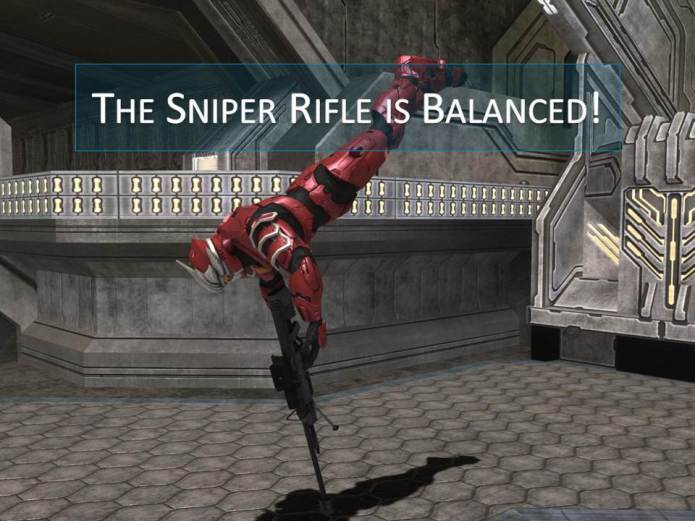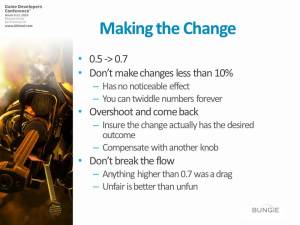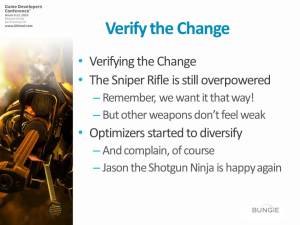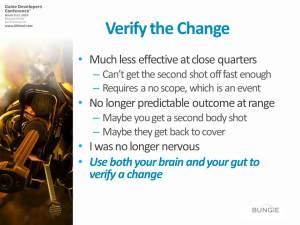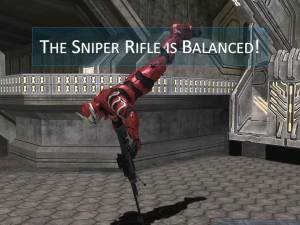

Ok, so when I gave this talk at GDC I didn’t have time to finish, even though I was talking very fast. I did better when I gave it at Blizzard, until my voice ran out and I could barely speak. So I probably should have cut some ideas out and saved them for this year.
I do see the irony of failing to trim a talk that advices designers to drastically reduce the scope of their game as early as possible. But to me, the value of GDC has always been that it makes me think about my own problems from a different perspective and inspires new ideas as I listen. So I wanted to cram as much idea-fodder into the talk as possible, not produce a fluid, polished experience.

I did not make the call on the Pistol, I didn’t even know about that call, it was made directly to the cache file after everything was supposed to be locked down, in fact… but I’m not bitter about it. I did decide to give the BR some spread, which has been the topic of much debate. Luckily Reach has been even more controversial, so nobody remembers it anymore. It’s interesting that every single Halo game has had major controversy over the MP starting weapon, I bet you could write an interesting talk about that.

In 2009 I was at the Art Institute of Chicago visiting my family. (I grew up in and around Chicago.) I saw one of the most famous paintings of all time and took a picture of it with my phone. I actually did have the idea for this talk at exactly that moment, at least vaguely. Any guesses as to the painting?

It’s “A Sunday Afternoon on the Island of La Grhand Zhot” by Zhorzh Soo-rah (I really wanted to pronounce his name right…heh) This painting inspired my talk (and its very long title) Still don’t recognize it? Here it is from a little farther back.

(I showed you the part in the lower right by the monkey)
This painting isn’t famous for how it looks, or what it shows, but how it was made.

Seurat lived in the 1800’s. He was very interested in how we perceive color. Scientists were just discovering that what we see as one color is actually a mixture of different colored light. To demonstrate this fact, he invented Pointillism, the artistic process of using tiny dots of basic colors to produce an image. The same way your printer does.
There is a really great play called Sunday in the Park with George that I recommend you see if you are interested in learning more. You can skip the final act, though.
 So I started thinking… What happens if we take Halo 3 and break it into it’s tiny details…
So I started thinking… What happens if we take Halo 3 and break it into it’s tiny details…

And analyze just one of them. Take one tiny Decision, and explore it exhaustively. Specifically, the time between shots for the sniper rifle. (I had a lot of fun putting together the pictures for this slide deck. I never tried to pointilize a screenshot before.)

So here is the actual title of my talk.
If you have been to GDC, you know that most of the talks are too broad to be really interesting. It doesn’t get much more specific than this! (Of course, I took this narrow topic and used it to explore lots of subjects and theories, but still…)

My opinions may not represent Bungie management. In fact, I know they don’t. (If I only knew the irony of that statement at the time!) My opinions may not represent reality; this is the past as I remember it, but as we will find out, brains are not reliable. All examples, even negative ones, are from good games. I tried to pick on games that everyone knows are great, to avoid controversy.
This talk was really hard to write! Really hard. The more specific the topic, the more there is to say. It ballooned to almost 300 slides, editing took forever (and it turns out I still didn’t edit it down enough!)

First, some context from Halo 2.

Halo 2 wasn’t just popular, it was popular for years and the Sniper Rifle remained balanced the whole time. It never needed to be changed, limited, banned, it was still fun.
This can give us a practical definition of Balance: Balance is Longevity.

(X= 3, I told them my talk would appeal to Engineers!)
Balancing an equation is a process. But game balance is a state that either exists or it doesn’t.

The 4th rule of Jenga makes it clear (say it with me):
4. Your turn ends 10 seconds after you stack your block
It isn’t balanced unless it lasts. (I bet you didn’t expect to see a Jenga reference!)

There have been other talks about Halo 2’s crunch; I’m not going to re-hash them. My really quick personal post-mortem: Don’t set yourself up to try and fix bugs in the Tutorial and balance the Weapons at the same time, It’s not going to work. At least not without wrecking your personal life.
Production is always worried about a repeat. (As you can tell during this talk, Production and I have a love-hate thing going. It is mostly a joke, but Deisgn and Production have very different goals and the game is only going to work if they cooperate.) They were always asking me when I am going to be done, so I invented the Balancer’s Paradox.
Balancer’s Paradox
– I can’t balance the Sniper Rifle damage until we set the Player’s health
– I can’t balance the player’s health until we know the engagement distance
– I can’t balance the engagement distance until we set the Sniper Rifle damage.
But after using this for awhile, I actually had to invent a solution… Balance in passes. The Sniper Rifle always has to be balanced! You could ship at any time! So you keep it balanced all the time. But there’s balanced, and then there’s balanced…

At the end of each pass, the game is balanced to a certain level. Once a game is balanced to that level, do not backtrack. Basically, what this means is that if you have balanced the strength of a game element, don’t make it weaker in order to limit the roles of that element. Unless you have to, of course, in whic case it will impact the schedule so you need to let Production know.
Halo 3’s Balance Passes are listed here. I think they would work for most games. They match with stages of game development and I’ll go over them in more detail later.

Remember: Balance is Longevity. And we could tell by playing it that it wasn’t going to last. We all had the same feeling and we didn’t really doubt it. But how did we know? We had developed our sense of balance.

In Outliers, Malcolm Gladwell lays out his 10,000 hour rule. This makes me the world’s only expert in trying to balance the Halo Sniper Rifle. Sort of a narrow expertise, I admit.

Niels Bohr offers this definition of an expert. This also makes me the world’s foremost expert in trying to balance the Halo Sniper Rifle (and in Driving too Fast for Conditions.)
But what are time and mistakes? They are just experience. So why is experience so much more important to being an expert than training, knowledge or talent? Because of how your brain works.
[Continue]
